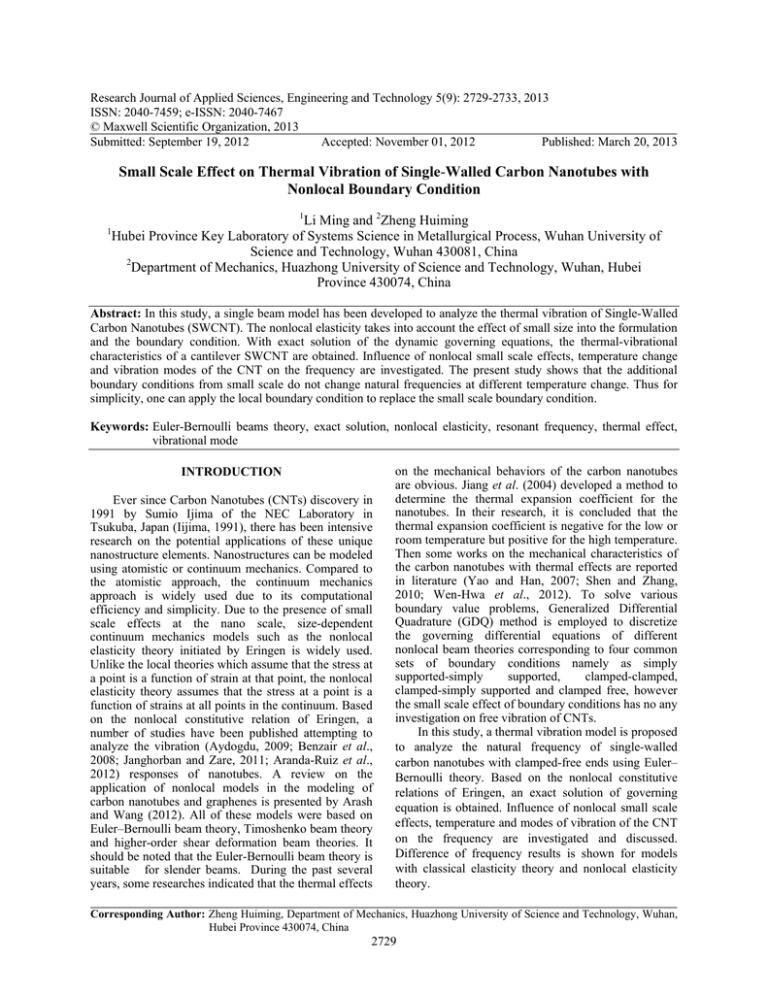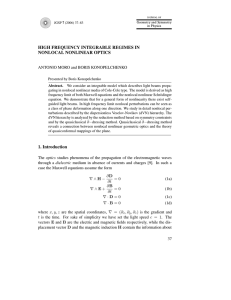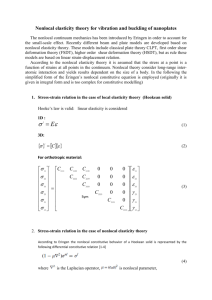Research Journal of Applied Sciences, Engineering and Technology 5(9): 2729-2733,... ISSN: 2040-7459; e-ISSN: 2040-7467
advertisement

Research Journal of Applied Sciences, Engineering and Technology 5(9): 2729-2733, 2013
ISSN: 2040-7459; e-ISSN: 2040-7467
© Maxwell Scientific Organization, 2013
Submitted: September 19, 2012
Accepted: November 01, 2012
Published: March 20, 2013
Small Scale Effect on Thermal Vibration of Single-Walled Carbon Nanotubes with
Nonlocal Boundary Condition
1
Li Ming and 2Zheng Huiming
Hubei Province Key Laboratory of Systems Science in Metallurgical Process, Wuhan University of
Science and Technology, Wuhan 430081, China
2
Department of Mechanics, Huazhong University of Science and Technology, Wuhan, Hubei
Province 430074, China
1
Abstract: In this study, a single beam model has been developed to analyze the thermal vibration of Single-Walled
Carbon Nanotubes (SWCNT). The nonlocal elasticity takes into account the effect of small size into the formulation
and the boundary condition. With exact solution of the dynamic governing equations, the thermal-vibrational
characteristics of a cantilever SWCNT are obtained. Influence of nonlocal small scale effects, temperature change
and vibration modes of the CNT on the frequency are investigated. The present study shows that the additional
boundary conditions from small scale do not change natural frequencies at different temperature change. Thus for
simplicity, one can apply the local boundary condition to replace the small scale boundary condition.
Keywords: Euler-Bernoulli beams theory, exact solution, nonlocal elasticity, resonant frequency, thermal effect,
vibrational mode
INTRODUCTION
Ever since Carbon Nanotubes (CNTs) discovery in
1991 by Sumio Ijima of the NEC Laboratory in
Tsukuba, Japan (Iijima, 1991), there has been intensive
research on the potential applications of these unique
nanostructure elements. Nanostructures can be modeled
using atomistic or continuum mechanics. Compared to
the atomistic approach, the continuum mechanics
approach is widely used due to its computational
efficiency and simplicity. Due to the presence of small
scale effects at the nano scale, size-dependent
continuum mechanics models such as the nonlocal
elasticity theory initiated by Eringen is widely used.
Unlike the local theories which assume that the stress at
a point is a function of strain at that point, the nonlocal
elasticity theory assumes that the stress at a point is a
function of strains at all points in the continuum. Based
on the nonlocal constitutive relation of Eringen, a
number of studies have been published attempting to
analyze the vibration (Aydogdu, 2009; Benzair et al.,
2008; Janghorban and Zare, 2011; Aranda-Ruiz et al.,
2012) responses of nanotubes. A review on the
application of nonlocal models in the modeling of
carbon nanotubes and graphenes is presented by Arash
and Wang (2012). All of these models were based on
Euler–Bernoulli beam theory, Timoshenko beam theory
and higher-order shear deformation beam theories. It
should be noted that the Euler-Bernoulli beam theory is
suitable for slender beams. During the past several
years, some researches indicated that the thermal effects
on the mechanical behaviors of the carbon nanotubes
are obvious. Jiang et al. (2004) developed a method to
determine the thermal expansion coefficient for the
nanotubes. In their research, it is concluded that the
thermal expansion coefficient is negative for the low or
room temperature but positive for the high temperature.
Then some works on the mechanical characteristics of
the carbon nanotubes with thermal effects are reported
in literature (Yao and Han, 2007; Shen and Zhang,
2010; Wen-Hwa et al., 2012). To solve various
boundary value problems, Generalized Differential
Quadrature (GDQ) method is employed to discretize
the governing differential equations of different
nonlocal beam theories corresponding to four common
sets of boundary conditions namely as simply
supported-simply
supported,
clamped-clamped,
clamped-simply supported and clamped free, however
the small scale effect of boundary conditions has no any
investigation on free vibration of CNTs.
In this study, a thermal vibration model is proposed
to analyze the natural frequency of single-walled
carbon nanotubes with clamped-free ends using Euler–
Bernoulli theory. Based on the nonlocal constitutive
relations of Eringen, an exact solution of governing
equation is obtained. Influence of nonlocal small scale
effects, temperature and modes of vibration of the CNT
on the frequency are investigated and discussed.
Difference of frequency results is shown for models
with classical elasticity theory and nonlocal elasticity
theory.
Corresponding Author: Zheng Huiming, Department of Mechanics, Huazhong University of Science and Technology, Wuhan,
Hubei Province 430074, China
2729
Res. J. Appl. Sci. Eng. Technol., 5(9): 2729-2733, 2013
where, α x is the coefficient of thermal expansion in the
direction of x axis and v is the Poisson’s ratio,
respectively. T denotes the change in temperature. In
the present study, it is assumed that only axial loads due
to temperature change exist on the SWCNT and
temperature change is considered at low or room
temperature. It should be noted that the Young’s
modulus is assumed to insensitive to temperature
change.
The boundary conditions of the nonlocal cantilever
beam theory are of the form as follows:
Fig. 1: Model of a cantilever SWCNT of length l
Basic equations: Many studies showed that the classic
Euler-elastic beam offers a simple and reliable model
for an overall mechanical deformation of CNTs,
provided the characteristic wavelength is much larger
than the diameter of CNTs. Therefore, the present study
the thermal effect on the vibration of SWCNTs
described by the Bernoulli–Euler beam model. In the
present theory the plane cross sections of the beam
remain plane during flexure and that the radius of
curvature of a bent beam is large compared to the
beam’s depth. In addition, CNT is assumed to be
clamped-free ends, shown in Fig. 1.
According to the Euler-Bernoulli beam theory (the
classical beam theory), the strain displacement relations
are given by:
ε xx = − z
∂2w
∂x 2
(1)
where x is the longitudinal coordinate measured from
the left end of the beam, z the coordinate measured
from the mid-plane of the beam, w the transverse
displacement. Consider a cantilever SWCNT of length
l. Young’s modulus E, material density ρ, crosssectional area A and cross-sectional inertia moment I,
The free vibration equation of this beam-modeled CNT
considering the thermal can be developed to become:
∂ M
∂ w
∂ w
− ρ A 2 + NT
=
0
∂x 2
∂t
∂x 2
2
Q=−
2
∂M
∂x
EA
α xT
1 − 2ν
M =0
(2)
,
∂w
= 0 at x = 0
∂x
(5)
x=l
(6)
Q = 0 at
,
As written, the governing equations and boundary
conditions appear of the same form as the local beam
theory, but it must be recognized that the bending
moment and shear force expressions for the nonlocal
beam theory are different due to the nonlocal
constitutive relations as will be demonstrated below
(Eringen and Edelen, 1972)
σ xx − (e0 a )2
∂ 2σ xx
= Eε xx
∂x 2
(7)
where σ xx is the normal stress, ε xx is the normal strain
and e 0 a is the scale coefficient that incorporates the
small scale effect. Note that a is the internal
characteristic length (e.g., lattice parameter, C–C bond
length and granular distance) and e 0 is a constant
appropriate to each material.
Considering M = ∫𝐴𝐴 𝜎𝜎𝑥𝑥𝑥𝑥 𝑧𝑧𝑧𝑧𝑧𝑧, multiplying Eq. (7)
by zdA and integrating the result over the area A yields:
M − ( e0 a )
2
2
∂2M
∂2w
=
− EI
2
∂x
∂x 2
(8)
By substituting the equilibrium Eq. (2) and (3) into
Eq. (8), one obtains:
(3)
where,
M
= The bending moment
Q
= The shear force
= The additional axial force arising due to
NT
thermal effects. On the basis of the theory of
thermal elasticity mechanics, the axial force
NT can be written as Zhang et al. (2008):
NT = −
w=0
∂2w
∂2w
∂2w
M =
− EI 2 + (e0 a ) 2 [ ρ A 2 − NT
]
∂x
∂t
∂x 2
(9)
∂3w
∂3w
∂ 3 w (10)
Q=
EI 3 − (e0 a ) 2 [ ρ A
− NT
]
2
∂x
∂x∂t
∂x 3
In view of Eq. (9) and (10), the governing
equations for the nonlocal Euler beams are given by:
(4)
2730
EI
∂4w
∂2w
∂2w
∂4w
∂4w
+ ρ A 2 − NT 2 − (e0 a)2 [ ρ A 2 2 − NT 4 ] =
0 (11)
4
∂x
∂t
∂x
∂x ∂t
∂x
Res. J. Appl. Sci. Eng. Technol., 5(9): 2729-2733, 2013
On the basis of Eq. (5) (9) and (6) (10), the
boundary conditions of the cantilever beam, associated
with the nonlocal Euler beam theory, are given as
follows:
w=0 ,
∂w
= 0at x = 0
∂x
For arbitrary ω, Eq. (16) has four roots
− s1 + s1 − 4 s0
2
2
k1, 2 = ±
(12)
s1 +
k3,4 = ± j
∂2w
∂2w
∂2w
M =
− EI
+ (e0 a ) 2 [ ρ A 2 − NT
]=
0
2
∂x
∂t
∂x 2
s12 − 4 s0
2
(17)
Thus
and
4
Q =EI
∂w
∂w
∂ w
2
− ( e0 a ) ρ A
− NT 3 =
= 0 at x = l
2
∂x3
∂
∂
∂x
x
t
3
3
w( x, t ) = ∑ C j e j eiωt
3
j =1
(13)
Now we determine the solution of Eq. (11) with
different boundary conditions. Let the solution be:
w( x, t ) = W0 e kx e iωt
(14)
EI + (e0 a ) 2 NT k 4 + (e0 a ) 2 ρ Aω 2 − NT k 2 − ρ Aω 2 =
0 (15)
let
(e0 a ) 2 ρ Aω 2 − NT / EI + (e0 a ) 2 NT
s=
1
− ρ Aω 2 / EI + (e0 a ) 2 NT
s0 =
yields:
(16)
(18)
The items C j (j=1, 2, 3, 4) are the constants
determined from the boundary conditions.
By substituting Eq. (18) into the boundary conditions
(12), (13), an eigenvalue problem may be set up as
defined by:
[ D]4× 4 {C1 , C2 , C3 , C4
where, ω is the circular natural frequency and W(x) is
the mode shape. Term i is the conventional imaginary
number.
Substituting the Eq. (14) into Eq. (11) yields
k 4 + s1k 2 + s0 = 0
k x
}T = 0
(19)
NUMERICAL RESULTS AND DISCUSSION
On the basis of the vibration results obtained, we
investigate the small scale effect of boundary condition
on the frequency with a numerical example. Consider a
(5, 5) armchair SWCNT with diameter d = 1 nm, lengths
l= 10d and with the following assumed mechanical
parameters: Young’s modulus E = 1 TPa, ρ = 2300kg/m3.
It is reported that all the coefficients of thermal expansion
for SWCNT are negative at low and room temperature
and are positive at high temperature. In the present study,
temperature change at low or room temperatures is
considered. The coefficient of thermal expansion α x = 1.6×106K.
1
1
0.5
0
0
-0.5
0
0.5
m=1
-1
1
1
1
0.5
0.5
0
0
-0.5
-0.5
-1
0
0.5
m=3
1
-1
0
0.5
m=2
1
0
0.5
m=4
1
Fig. 2: The fisrt four mode shapes of the cantilever SWCNT with deferent theories for T = 50K and e 0 a = 1nm (dashed line:
Local Euler; dotted line: Nonlocal euler without nonlocal boundary; continuous line: Nonlocal euler with nonlocal
boundary)
2731
Res. J. Appl. Sci. Eng. Technol., 5(9): 2729-2733, 2013
1
1
0.5
0
0
-0.5
0
0.5
m=1
-1
1
1
1
0.5
0.5
0
0
-0.5
-0.5
-1
0
0.5
m=3
-1
1
0
0.5
m=2
1
0
0.5
m=4
1
Fig. 3: The fisrt four mode shapes of the cantilever SWCNT with deferent theories for T = 50K and e 0 a = 2nm (dashed line:
Local euler; dotted line: Nonlocal euler without nonlocal boundary; continuous line: Nonlocal euler with nonlocal
boundary)
Table 1: Dependence of the small-scale parameter on the first five free frequencies of the cantilever SWCNT with/without nonlocal boundary
conditions (T = 50K) (LE: Local Euler; NE: Nonlocal Euler without nonlocal boundary; NEB: Nonlocal Euler with Nonlocal
Boundary)
e 0 a [nm]
0
0.5
1
2
------------------------------------------------------------------------------------Frequency [GHz] /Small scale / Mode
LE
NE
NEB
NE
NEB
NE
NEB
1
29.444
29.444
29.444
29.444
29.444
29.444
29.444
2
183.35
180.80
180.80
171.89
171.89
147.06
147.06
3
513.12
485.10
485.10
423.99
423.99
307.49
307.49
4
1003.3
898.91
898.91
711.74
711.74
452.00
452.00
5
1659.0
1387.8
1387.8
1008.4
1008.4
599.70
599.70
Table 2: Dependence of the small-scale parameter on the first five free frequencies of the cantilever SWCNT with/without nonlocal boundary
conditions. (T = 0K); (LE: Local Euler; NE: Nonlocal Euler without nonlocal boundary; NEB: Nonlocal Euler with Nonlocal
Boundary)
e 0 a [nm]
0
0.5
1
2
-------------------------------------------------------------------------------------Frequency [GHz] /Small scale / Mode
LE
NE
NEB
NE
NEB
NE
NEB
1
29.444
29.444
29.444
29.444
29.444
29.444
29.444
2
182.71
180.16
180.16
171.25
171.25
145.79
145.79
3
511.84
485.10
485.10
423.99
423.99
304.94
304.94
4
1003.3
897.63
897.63
711.10
711.10
449.45
449.45
5
1657.8
1386.6
1386.6
1006.5
1006.5
597.15
597.15
For same temperature change T, Fig. 2 and 3
illustrate the dependence of the first four mode shapes
on the small scale with/whithout classical and small
scale boundary conditions. It is clearly seen from these
figures that for different theories, the mode shapes are
actually significant difference. Furthermore with either
larger values of m or lager values of e 0 a, this difference
becomes very strong. This means that the application of
the nonlocal boundary conditions for CNT analysis
would lead to significant change for the mode shapes.
The reason for this phenomenon is, for a cantilever
SWCNT, the boundary conditions at the free end has an
obvious difference between the classical and small
scale boundary conditions.
However, the small scale has not effect on
frequency of nanotube when the nonlocal elastical
theory is considered in boundary conditions. With the
temperature change T = 0 K and 50K, the results of the
first five frequencies of SWCNTs based on small scale
are listed in Table 1 and 2, respectively. It can be seen
from Table 1 and 2 that based on nanobeam, the
frequencies have not change with/without classical and
small scale boundary conditions for the different T and
mode number m. This means that the scale effect on
boundary conditions can be neglected when the thermal
vibration of SWCNT is analyzed based on nonlocal
elasticity theory. On basis of virtual work principle, this
phenomenon can be explained that the virtual work
made from small scale shear force and moment at the
both ends cancel each other in viewpoint of energy or
work.
CONCLUSION
In this study, the thermal vibration analysis of
SWCNT with/without small scale boundary and
nonlocal beam theory using exact solution has been
performed. Since the additional work made by the
moment and shear force at the free end from small scale
2732
Res. J. Appl. Sci. Eng. Technol., 5(9): 2729-2733, 2013
effect cancel each other, small scale boundary do not
change natural frequencies. With this finding, in the
cases of thermal vibration analysis using analytical
solution, the boundary conditions due to local elasticity
and nonlocal elasticity are also equivalent. Thus for
simplicity, we can apply the local boundary condition
to replace the small scale boundary condition.
ACKNOWLEDGMENT
This study is supported by Open fund project
(No.Y201109) of Hubei Province Key Laboratory of
Systems Science in Metallurgical Process, China.
REFERENCES
Aranda-Ruiz, J., J. Loya and J. Fernández-Sáez, 2012.
Bending vibrations of rotating non-uniform
nanocantilevers using the Eringen nonlocal
elasticity theory. Compos. Struct., 94: 2990-3001.
Arash, B. and Q. Wang, 2012. A review on the
application of nonlocal elastic models in modeling
of carbon nanotubes and graphenes. Comp. Mater.
Sci., 51(1): 303-313.
Aydogdu, M., 2009. Axial vibration of the nanorods
with the nonlocal continuum rod model. Physica.
E., 41: 861-864.
Benzair, A., A. Tounsi, A. Besseghier, H. Heireche, N.
Moulay and L. Boumia, 2008. The thermal effect
on vibration of single-walled carbon nanotubes
using nonlocal Timoshenko beam theory. J. Phys.
D Appl. Phys., 41: 225-404.
Eringen, A.C. and D.Q.B. Edelen, 1972. On nonlocal
elasticity. Int. J. Eng. Sci., 1: 233-248.
Iijima, S., 1991. Helical microtubules of graphitic
carbon. Nature, 354: 56-58.
Janghorban, M. and A. Zare, 2011. Free vibration
analysis of functionally graded carbon nanotubes
with variable thickness by differential quadrature
method. Physica. E, 43: 1602-1604.
Jiang, H., B. Liu, Y. Huang and K.C. Hwang, 2004.
Thermal expansion of single wall carbon
nanotubes. J. Eng. Mater. T., 126: 265-270.
Shen, H.S. and C.L. Zhang, 2010. Thermal buckling
and postbuckling behavior of functionally graded
carbon nanotube-reinforced composite plates. Mat.
Des., 31: 3403-3411.
Wen-Hwa, C., W. Chun-Hung, L. Yang-Lun and C.
Hsien-Chie, 2012. A theoretical investigation of
thermal effects on vibrational behaviors of singlewalled carbon nanotubes. Comp. Mater. Sci., 53:
226-233.
Yao, X.H. and Q. Han, 2007. Investigation of axially
compressed buckling of a multi-walled carbon
nanotube under temperature field. Compos. Sci.
Technol., 67: 125-134.
Zhang, Y.Q., X. Liu and J.H. Zhao, 2008. Influence of
temperature change on column buckling of
multiwall carbon nanotubes. Phys. Lett. A,
372(10): 1676-1681.
2733






